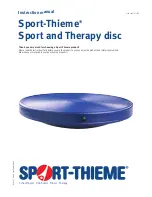
3
Changing position on the disc
Starting position: basic position
1. Alternate shifting of weight from balls of the feet to heels (Ill. 6). Do the same
alternation from left and right (Ill. 7).
2. Move both feet alternately up to the foot’s secure positioning over the centre point *).
3. Move parallel feet forwards and backwards.
4. Using the feet, turn the disc to the left and the right without changing the front**).
5. Turn the body on the disc. The disc itself should not turn (Ill. 8).
*) With this exercise, it is impossible not to use the short foot muscles; children often
‚cheat‘ by doing small jumps during the forward and backward movement of the feet,
which should be avoided.
**) The screw-like connection of the feet and standing surface is enhanced when the heels
(not the ankles) push slightly towards each other despite the parallel positioning with
gap. Thus, the knees remain rolled out, bow legs are avoided and the pelvis stays
straight. This position immediately makes the user feel more secure. The following
exercises work best when the feet remain in the inner circle.
Basic exercises in standing position
Basic position: (apparatus‘ flat side up). When climbing onto the disc, move the
foot‘s inner edge over the centre line so that it arches by itself when weight is
applied (Ill. 3). The line runs from below the heel towards the second toe. The
disc‘s centre is covered by the foot. Place the free leg without putting weight on
it next to the standing leg (Ill. 4). From this position, put weight on both legs and
change the position of the feet in such a way that the centre point becomes visible
between the two parallel feet (Ill. 5). Hold balance using the feet only.
• For children who aren’t as strong, it is recommended to start with exercises in a
sitting or kneeling position as the immediate effect on the core muscles is much
stronger here.
• When mastery is achieved, stepping onto the apparatus can be replaced by a
standing jump. Focussing on the centre point makes the jump easier.
Exercise with complete inactivity of the short foot muscles:
2. Whilst seated (stool, chair etc.) place the foot on the middle of the disc and against low
resistance, try to turn the disc inwards with the foot placed flat on the surface (Ill. 2).
Ill. 2
Ill. 4
Ill. 5
Ill. 3
Ill. 6
Ill. 7
Ill. 8
Preparatory exercises with the therapy disc
1. Balancing on the therapy disc (Ill. 1).
Ill. 1
Instruction manual
for Prod. code 127 7702
School Sports · Club Sports · Fitness · Therapy







